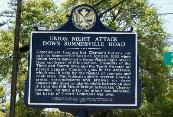 |
| Marker on Summerville Road |
The Battle of Columbus (also called the Battle of Girard) took place on April 16, 1865, an Easter Sunday. General Robert E. Lee had surrendered the Army of Northern Virginia at Appomatox Court House one week earlier and General Joseph E. Johnston would meet with General William Tecumseh Sherman in North Carolina the next day to discuss the surrender of Confederate forces in the Deep South.
It was in the last days of the war that Union Major General James H. Wilson pushed east from Montgomery, battling Confederate forces as he approached Auburn. By the mid-point of the month he was driving east from Auburn, moving fast with thousands of troops to seize the vital bridges over the Chattahoochee and destroy the vast wartime industrial complex in Columbus.
 |
| Site of 14th Street Bridge |
The initial attack developed on the afternoon of April 16, 1865, when part of Wilson's command made a dash for the "lower" or Dillingham Street bridge. This force, carried out by part of Upton's Division, was repulsed.
 |
| Surviving Earthworks in Phenix City |
 |
| Battery Site at Russell County Courthouse |
The battle now collapsed into a confusing night fight, but by 10 p.m. the upper bridge had been taken and Columbus had fallen. The impact on the Southern war effort was devastating. Not only were the factories destroyed, but the nearly complete ironclade C.S.S. Jackson was captured and the warship C.S.S. Chattahoochee was burned by its own crew to prevent its capture. No other battle between Union and Confederate forces would be fought on the scale of the action at Phenix City and Columbus.
To learn more about the Battle of Columbus (Girard), please visit www.exploresouthernhistory.com/battleofcolumbus.

